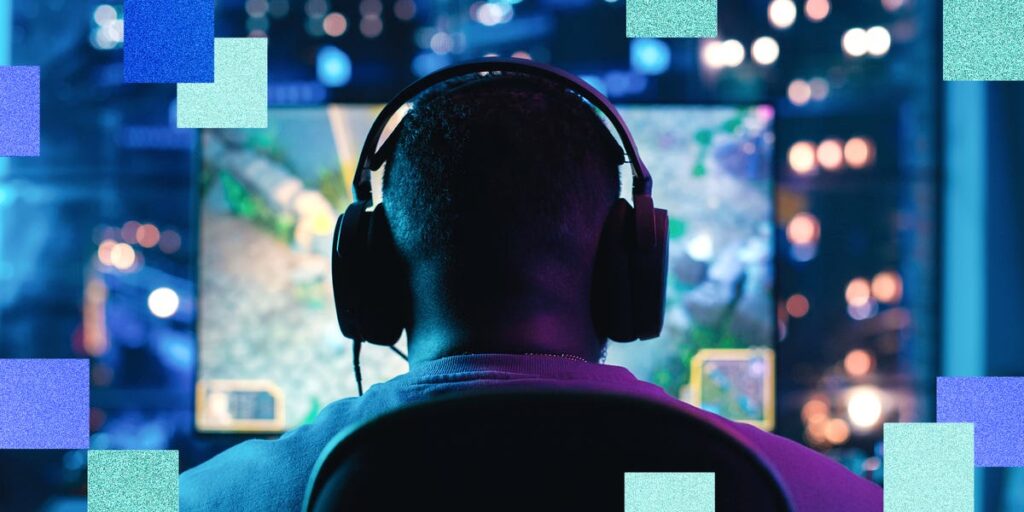An AI-powered Darth Vader probably wasn’t on any Fortnite player’s 2025 bingo card, but gamers still rushed to have a conversation with the character in-game. Instead of saying pre-programmed lines, the chatbot could tell jokes when prompted and even mock a player’s achievements.
Though this feature was a temporary experiment, it showed that AI is far more than a side quest for the gaming industry.
Artificial intelligence has long been a part of video game development. So recent advancements in machine learning and generative AI have led studios to use the tech to speed up production and make gameplay more immersive.
The Game Developer Conference’s 2025 State of the Game Industry report found 52% of surveyed developers work at companies that use generative AI tools. At large video game companies, like Ubisoft, machine learning is helping accelerate development, automate laborious tasks, and free up developers and artists to focus on the most important game elements and characters. These companies are also experimenting with new game features, such as non-player characters that use GenAI to have better in-game conversations with players.
Meanwhile, many indie developers and independent studios are leading the charge on AI-native games built around tech, like large language models, which are redefining the development process. As studios big and small weigh the monetary expense of this new tech, they are also navigating how to use AI in a way that is fair and fun for both game makers and players.
AI can streamline game production
At Ubisoft, machine learning is already working behind the scenes to speed up the creation process. For the action-adventure game “Assassin’s Creed Shadows,” the 3D creation tool, FaceShifter, has helped artists generate and model heads for secondary characters.
The tool uses a proprietary dataset of 3D-scanned heads to design new models with different characteristics. Yves Jacquier, the executive director of Ubisoft’s research and development lab, La Forge, said a high-resolution head can typically take a week to create, but FaceShifter can quickly give artists a foundation to iterate on and free up their time to focus on more important characters.
“With this technology, you have something believable with a few tweaks in less than half a day,” Jacquier said.
Generative AI has also helped automate complex tasks for developers at King, a mobile-gaming company, by boosting production speeds and improving live operations, or continuous in-game updates. Luka Crnkovic-Friis, the head of AI and machine learning, told Business Insider that AI acts as a “co-pilot” for King’s game makers.
“It helps us write and review code faster, run playtesting at scale, and tune mechanics across tens of thousands of levels,” Crnkovic-Friis said in an email to Business Insider.
For King’s popular puzzle game, “Candy Crush Saga,” which has over 19,000 levels, Crnkovic-Friis said his team uses AI tools, such as OpenAI’s Codex CLI and Anthropic’s Claude Code, to test levels, make design adjustments, and refine the game.
At Jam and Tea Studios, AI is even more of an influential collaborator in the development process. The early-stage studio developed “Retail Mage,” an AI-native job-simulation game, with LLMs to create more dynamic interactions with NPCs and the game’s environment. This meant a lot of the development process was in English, instead of a coding language, which made production accessible to more team members and contributed to faster creation.
“As soon as we had that technology internally in the game to be able to quickly and rapidly generate content and generate dialogue and generate experiences, our iteration process — it just skyrocketed,” said Aaron Farr, the cofounder and CTO of Jam and Tea Studios. “We built Retail Mage in approximately 5 months, which is an insane speed.”
AI-powered gameplay is experimental and costly
While many studios are already using machine learning and genAI to improve their development processes, the industry is still experimenting with how the tech can reshape the player experience.
Ubisoft has used AI to create smarter programming for NPCs and moderate in-game chats. But more dynamic gameplay features, such as its NEO NPC project, which uses LLMs for spontaneous dialogue, are still in the prototype phase.
Jacquier said such gameplay features are more experimental because studios want to ensure that LLMs, for example, don’t hallucinate. He said it’s also important that the tech is fun and purposeful, not just a “very expensive gadget” that no one cares about.
The cost of this experimental technology was a challenge for Jam and Tea Studios when making “Retail Mage.” The software and hardware, including cloud technology and graphics processing units, required to run a generative AI model can come with a high price tag. Farr said this is partially why there aren’t many AI-native games on the market yet.
“We nearly didn’t do ‘Retail Mage’ because we thought it was too expensive,” Farr said. “It’s not that I couldn’t build it. It’s that it would have been too expensive to run.”
Using AI responsibly is an ongoing conversation
As AI changes the way game makers and creatives work, studios are also navigating how to use the tech mindfully and responsibly.
For Jacquier, this means examining the entire development process when adding in new technology. This big-picture approach is also helping his team find new ways to continue working with creative talent, like video game actors.
“You must not think technology, you must think about your whole ecosystem,” Jacquier said. “This is the only way to make sure that, at least from a creative standpoint, you remain sustainable.”
While best practices in the industry are still emerging, Crnkovic-Friis said using authorized sources, maintaining transparency, and keeping humans involved are among his guiding principles.
“Responsible adoption means moving just as fast on skills, safeguards, and inclusion as we do on features,” he told Business Insider.
Farr said AI has the power to encourage more creativity and build games that respond to players more than ever before. But to do that ethically, the industry needs to have continuous dialogue about the tech’s role, he added.
“We want to build the future that we want to live in,” Farr said. “The first risk is not engaging in the conversation. If we care about the future, we need to build it together as both creatives and technologists.”
Read the full article here
















